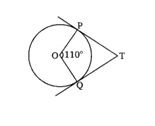Circles

summary
A circle is a set of all points in a plane at a fixed distance from a fixed point in a plane. The fixed point is called the center of the circle. The fixed distance is called the radius of the circle.

Radius:The constant distance is called the radius.
Chord: The line joining two points on the circumference of the circle is called a chord. The longest chord is the diameter of the circle.
Diameter: The chord which is passing through the centre of the circle. It is the biggest chord in the circle . It is twice the radius.

Sector of a circle: The region enclosed by two radii and the corresponding arc is called a sector of the circle.
Segment of the circle: The region bounded by an arc and the corresponding chord is called the segment of the circle.
Tangent
A tangent to a circle is a straight line which touches the circle at only one point. The point where the tangent touches the circle is called point of contact of the tangent to the circle.
A tangent to a circle is a special case of a secant, when the two ends points of its corresponding chord coincides.
(i) At any point on the circle there can be one and only one tangent.
(ii) The line containing the radius through the point of contact is called the normal to the circle at the point.
Number of Tangents from a Point to Circle

(i)No tangent can be drawn from the point lying inside the circle, as shown in fig. (i)
(ii) One and only one tangent can be drawn from a point lying on the circle, as shown in fig. (ii)
(iii) Only two tangents can be drawn from an exterior point to a circle, as shown in fig.
1.Tangent to a Circle : It is a line that intersects the circle at only one point.

There is only one tangent at a point of the circle.
No tangent can be drawn from a point inside the circle.
Point of contact: The common point between the circle and the tangent is called the point of contact. ‘A’
The tangent at any point of a circle is perpendicular to the radius through the point of contact.
The lengths of tangents drawn from an external point to a circle are equal.
1.Secant: A line which has only two points common to a circle is called the secant.
Theorem 1: Prove that the tangent at any point of a circle is perpendicular to the radius through the point of contact.

- Given: XY is a tangent at point P to the circle with centre O.
- To prove: OP ⊥ XY
- Construction: Take a point Q on XY other than P and join OQ
- Proof: If point Q lies inside the circle, then XY will become a secant and not a tangent to the circle
OQ > OP - Since this happens with every point on the line XY except the point P. OP is the shortest of all the distances of the point O to the points of XY
OP ⊥ XY …[Shortest side is the perpendicular]
Theorem 2: Prove that the lengths of tangents drawn from an external point to a circle are equal

- Given: PT and PS are tangents from an external point P to the circle with centre O.
- To prove: PT = PS
- Construction: Join O to P, T and S.
- Proof: In ∆OTP and ∆OSP.
OT = OS …[radii of the same circle]
OP = OP …[common]
∠OTP = ∠OSP …[each 90°]
∆OTP = ∆OSP …[R.H.S.]
PT = PS …[c.p.c.t.]
Hence proved.

Note: If two tangents are drawn to a circle from an external point, then: •They subtend equal angles at the centre i.e., ∠1 = ∠2. •They are equally inclined to the segment joining the centre to that point i.e., ∠3 = ∠4.
∠OAP = ∠OAQ
Exercise 4.1
1. How many tangents can a circle have?
Solution:There can be infinitely many tangents to a circle.
2. Fill in the blanks
(i)A tangent to a circle intersects it in One…point(s).
(ii) A line intersecting a circle in two points is called a Secant……… .
(iii) A circle can have …Two… parallel tangents at the most.
(iv) The common point of a tangent to a circle and the circle is called …Point of contact…….. .
2. A tangent PQ at a point P of a circle of radius 5 cm meets a line through the centre O at a point Q so that OQ = 12 cm. Length PQ is
(a) 12 cm (b) 13 cm (c) 8.5 cm (d) √119 cm
Solution:

Radius of the circles=5cm
oQ-12 cm
opq =90
(The tengent to a circles is perpendicular to the radiusthrough the point of contact)
Pq2=oq2-op2(by Pythagoras theorem)
Pq2=122-52=144-25=199
Pq=√199 cm
Hence correct option is (d)
4. Draw a circle and two lines parallel to a given line such that one is a tangent and the other, a secant to the circle.
Solution:Here the given line CD is tangent to the given circle at the point M and parallel to AB and Ef is secent parallel to parallel to AB

Exercise 4.2
In Q.1 to 3 choose the correct option and give justification
1. From a point Q, the length of the tangent to a circle is 24 cm and the distance of Q from the centre is 25 cm. The radius of the circle is
a) 7 cm (b) 12 cm (c) 15 cm (d) 24.5 cm

The correct option is (A)
Justification:
Let OT be x cm.
Then in right ΔQTO,
QO2=QT2+OT2
(By Pythagoras’s Theorem)
=(25)2=(24)2+x2
=x2=625-576=49
=x=√49=7cm
2. In figure, if TP and TQ are the two tangents to a circle with centre O so that ∠POQ = 110°, then ∠PTQ is equal to
a) 60° (b) 70° (c) 80° (d) 90°

√ OPT=900
√OQT=900
√POQ=1100
TPOQ is a quadrilateral,
Therefore √PTQ+√POQ=1800
=√PTQ=180o-1100=700
Hence, correct option is (b)
3. If tangents PA and PB from a point P to a circle with centre O are inclined to each other at angle of 80°, then ∠POA is equal to
(a) 50° (b) 60° (c) 70° (d) 80°

The correct option I (A)
Justification:
In ΔPOA and ΔPOB,
√PAO=√PBO
OA=OB
PA=PB
ΔPOA=ΔPOB
=√APO=√BPO
=√APO=1/2 √APB=1/2X800=400
In ΔPAO, √APO+√POA+√OAP=1800
=400+√POA+900=1800
√POA=500
4. Prove that the tangents drawn at the ends of a diameter of a circle are parallel.
Solution:

5. Prove that the perpendicular at the point of contact to the tangent to a circle passes through the centre.
Solution:

In the given figure AxB is the tangents o a circle with o
Here OX is the line perpendicular to the tangent AxB at the point of context X
The we have
OXB+BXY=900+900=1800
Oxy is collinear I,e ox passes through the centre of the circle
Hence proved.
6.The length of a tangent from a point A at distance 5 cm from the centre of the circle is 4 cm. Find the radius of the circle.

OA=5CM, AP=4CM
OP=Radius of the circle
√OPA=900(Radius and tangents are perpendicular)
OA2=AP2+OP2 (By Pythagoras theorem)
52=42+op2=25=16+op2
=25-16=op2=9=OP2=√9=OP
=OP=3CM
RADIUS =3CM
7. Two concentric circles are of radii 5 cm and 3 cm. Find the length of the chord of the larger circle which touches the smaller circle.

Given: radii 5 cm and 3 cm
To Find: length of the chord of the larger circle
Solution:Consider a ∆ OAP it is right angle at P [ by theorem radius is ꓕ to tangent]
By pythagoras theorem,
OA2 = OP2 + AP2 Consider a ∆ OPB
52 = 32 + AP2 OB2 = OP2 + BP2
AP2 = 25 – 9 52 = 32 + BP2
AP2 = 25 – 9 BP2 = 25 – 9
= 16 = 16
AP = √16 BP = √16
AP = 4 cm. BP = 4 cm.
∴ AP + BP = 4 + 4 = 8 cm.
∴ A chord AB = 8 cm.
AP = 4 cm.
8. A quadrilateral ABCD is drawn to circumscribe a circle (see figure). Prove that AB + CD = AD + BC.

Solution:AP = AS ………(1)
[Lengths of a tangents from an external point are equal by theorem]
BP = BQ ………(ii)
CR = CQ………(iii)
CR = DS………(iv)
Adding equations (i), (ii), (iii) and (iv), we get
AP + BP + CR + DR = AS + BQ + CQ + DS
( AP + BP) + (CR + DR) = (AS + DS) + (BQ + CQ)
AB= CD = AD + BC
Hence proved.
9. In figure, XY and X’Y’ are two parallel tangents to a circle , x with centre O and another tangent AB with point of contact C intersecting XY at A and X’Y’ at B. Prove that ∠AOB = 90°.

Given: XY and X’Y’ are two parallel tangents to a circle & another tangent AB with point of contact C
To Prove: ∠AOB = 90°.
Solution:In a quadrilateral PABQ
∠P + ∠B + ∠A + ∠Q =3600
900 + 2x + 2y + 900 = 3600
2 (X + y) = 360 -1800 =1800
X + Y = 900
In ∆ ABD
∠A + ∠O +∠ B = 1800
⇒X +∠O + Y = 1800
⇒X + y +∠O = 1800
⇒900 +∠O = 1800
⇒∠O= 1800 – 900
∴ ∠O = 900
10. Prove that the angle between the two tangents drawn from an external point to a circle is supplementary to the angle subtended by the line segment joining the points of contact at the centre.
Solution

PA and PB are two tangents A and B are the points of contact of the tangent
Pa and PB are two tangents A and B are the points of contact of the tangents
OA is perpendicular AP and obis perpendicular to BP
Angel OAP=angles OBP =90
Radium and tangents are perpendicular to each other.
P in quadrilateral OAPB
OAP +OBP+APB+AOB=360
=90+90+APB+AOB=360
APB+AOB=360-180=180
Hence APB and AOB are supplementary angles.
11. Prove that the parallelogram circumscribing a circle is a rhombus
Solution:

ABCD is a parallelogram therefore
AB=CD (1)
BC=AB (2)
We know that the tangents drawn from same external point to circle are equal
DR=DS (Tangents drawns from point D) (3)
CR=CQ (Tangents drawns from point C) (4)
BP=BQ (Tangents drawns from point C) (5)
AP=As (Tangents drawns from point A) (6)
Adding (3) and (5),(5) and (6) we have
DR+CR+BP+AP=DS+CQ+BQ+AS
=(DR+CR)+(BP+AP)=(DS+AS)+(CS+DQ)
=CD+AB=AD+BC
From (1)and 2 we have
2AB=2BC=AB=BC
FROM (1),(2)AND (7) WE HAVE
AB=BC=CD=DA
Hence ABCD IS A RHOMBUS
12. A triangle ABC is drawn to circumscribe a circle of radius 4 cm such that the segments BD and DC into which BC is divided by the point of contact D are of lengths 8 cm and 6 cm respectively (see figure). Find the sides AB and AC.

BD=8CM AND DC=6CM
BE=BD=8CM
CD=CF=6CM
Let AE=AF=XCM
IN ABC, A=6+8=14CM
B=(X+6)CM
C=(X+8) CM
S=a+b+c/2=14+x+6+x+8/2=2x+28/2=(x+14)cm
Ar(ABC)=√S(S-a)(s-b)(s-c)
=√(x+14)xx+8+6=√48xX(x+14)cm2
ar(ABC)=AR(OBC)+AR(OCA)+AR(OAB)
=1/2x4XA+1/2X4XB+1/2X4XC
=2A+2B+2C=2(A+B+C)=2X2(X+14)
From (i) and (ii), we get
√48x(x+14)=4(x+14)=48x(x+14)=42(x+14)2
=48x(x+14)=16(x+14)2=3x(x+14)=(x+14)2
=3x=x+14=2x=14=x=7
AB=X=8=7+8=15CM
AC=X+6=7+6=13CM
13. Prove that opposite sides of a quadrilateral circumscribing a circle subtend supplementary angles at the centre of the circle.

From the figure we observe that OA bisects
˂SOP.
So ˂a= ˂b (1)
similarly ˂c= ˂d (2)
˂e= ˂f (3)
˂g= ˂h (4)
Therefore 2(˂a+˂h+˂e+˂d)= 360
=(˂a+˂h+˂e+˂d)=180
=(˂a+˂h+˂e+˂d)=AOB+(˂a+˂h+˂e+˂d)=DOC=180
Similarly ˂AOB +BOC)=180
Thus opposites sides of quadrilaterals ABCD SUBSTEND SUPPLEMENTARY angles at the Center of the circle of a circle.
hence proved.
Example: two tangents TP and TQ are drawn to circle with centre 0 from an external point T. Prove that PTQ=2˂OPQ.

Given: TP = TQ
TO PROVE PTQ=2˂OPQ
SOLUTION:In ∆ TPQ, TP = TQ
∠3 = ∠2, ………(I)[corresponding angles of an isosceles triangle]
Now PT is a tangent and OP is radius
Therefore, OP ꓕ TP
So, ∠OPT = 900
∠2 + ∠4 = 900 ,∠2 = 900 – ∠4………..(ii
In ∆ TPQ, ∠T + ∠P +∠ Q = 1800
From (i), (ii) & (iii)
∠1 + ∠2 + ∠2 = 1800
∠1 + 2∠2= 1800
∠1 + 2( 90 -∠4) = 1800 [ from (ii)]
∠1 + 2x 90) – 2 ∠4 = 1800
∠1 + 1800 – 2 ∠4 = 1800
∠1 = 2 ∠4
Hence proved




























